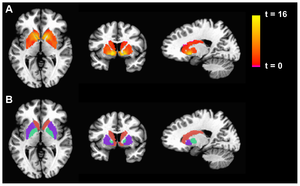Basal ganglia
From MEpedia, a crowd-sourced encyclopedia of ME and CFS science and history

Reduced Activation in Basal Ganglia Structures in CFS compared to Controls for the Win-Lose Contrast.[1]
Source: Miller et al. (2014). PLoS ONE 9(5): e98156. doi:10.1371/journal.pone.0098156
Source: Miller et al. (2014). PLoS ONE 9(5): e98156. doi:10.1371/journal.pone.0098156
Basal ganglia are a set of structures in the brain regulated by dopamine that play a role in action selection, voluntary movements and executive function, as well as perception of effort.
ME/CFS[edit | edit source]
A small study of chronic fatigue syndrome patients found increased choline in the basal ganglia.[2] Increased choline can be a sign of immune activation or increased cell membrane turnover.
Notable studies[edit | edit source]
- 2014, Decreased Basal Ganglia Activation in Subjects with Chronic Fatigue Syndrome: Association with Symptoms of Fatigue[1] (Full text)
- 2003, Proton magnetic resonance spectroscopy of basal ganglia in chronic fatigue syndrome[2] (Full text)
Learn more[edit | edit source]
See also[edit | edit source]
References[edit | edit source]
- ↑ 1.0 1.1 Miller, Andrew H.; Jones, James F.; Drake, Daniel F.; Tian, Hao; Unger, Elizabeth R.; Pagnoni, Giuseppe (May 23, 2014). "Decreased Basal Ganglia Activation in Subjects with Chronic Fatigue Syndrome: Association with Symptoms of Fatigue". PLoS ONE. 9 (5): e98156. doi:10.1371/journal.pone.0098156. ISSN 1932-6203. PMC 4032274. PMID 24858857.
- ↑ 2.0 2.1 Chaudhuri, A.; Condon, B.R.; Gow, J.W.; Brennan, D.; Hadley, D.M. (February 10, 2003). "Proton magnetic resonance spectroscopy of basal ganglia in chronic fatigue syndrome". NeuroReport. 14 (2): 225. ISSN 0959-4965. PMID 12598734. Retrieved September 3, 2019.

